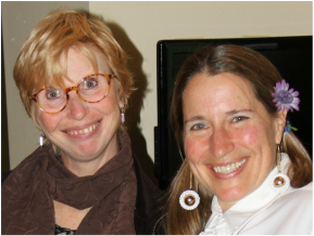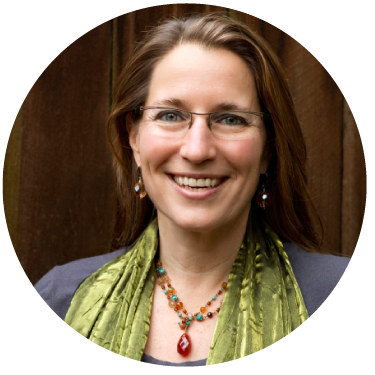 Click our cute photo to go to Marcy's blog
Click our cute photo to go to Marcy's blog At Marcy's request I too submitted an essay for the anthology, I Am With You, Love Letters to Cancer Patients. Reading my piece now, on advocating for a friend, I think it contains plenty of good advice which I hope will empower others to step up.
But it also reminds me of how much doing helps me cope with the anxiety, confusion, and grief of having a dear friend receive her death sentence. Being with that reality, being a friend first and foremost, is often much harder than executing a list of practical tasks.
As a coda to the essay I was asked for a short list of "what gets me through the angst of cancer." I wrote:
1. Being active: doing what I can to ease the suffering of those living with cancer.
2. Remembering well: honoring the memory and legacy of those who’ve died, keeping them alive in the world through valuing all that their life and death nourished.
3. Getting ready: learning everything I can about living with and dying of cancer, and how to grieve the sickness and death of loved ones, to become more skillful at living with a heart broken open by it all.
Becoming more skillful at living with a heart broken open by it all - that is a work in progress.

by Holly Pruett
Ever since funeral directors offered to "undertake" whatever families couldn't handle, care for our beloved dying and dead has become the purview of professionals. These days, specialists function more like “partialists”. For the newly diagnosed and those living with a terminal illness, who keeps track of the big picture? Who helps navigate the whirling maze of doctors, pharmacies, clinical trials, treatment appointments, complementary care, and insurance coverage, not to mention basic household management?
It’s easy to feel intimidated by the complexities of the medical-industrial complex; easy to feel defeated by a terminal or life-threatening diagnosis compounded by a seemingly endless array of needs.
That’s why we, friends of those living with dying, need to step up. In 2010 my close friend Marcy Westerling was diagnosed, out of the blue, with Stage IV ovarian cancer. I’ve been privileged to be by her side from the first bleak night after she received her diagnosis, alone in her car on the side of the highway. Her suffering sadness me deeply; the chance to “do something” to ease the way provides some measure of solace.
Of the various forms of support I’ve helped put in place (detailed below), what Marcy has valued the most is direct advocacy with the system to cut through its red-tape and endless denials. In her words, she’d like to see more of us “stubbornly pushing and pushing and meeting all the insipid and occasionally useful demands of the system” to get our loved ones into the best trials and providers. Taking on the calls and faxes and tracking, telling the back-story again and again, asking about things that seem off the table – what Marcy describes as “the things that would have overwhelmed me on my own and overwhelm most peer patients I know as they settle for what is offered them versus what might benefit them more.”
Here are some of the practices that have helped us, Marcy’s close circle of friends, advocate on her behalf and walk with her into Cancer World.
1. Assemble a Health Profile – Chances are, a second opinion is in order, along with applications for clinical trials, and access to any number of other providers. As a friend, you can help by pulling all of the information together into a single document. This Health Profile should include the person’s date of birth, spouse, contact information, and insurance policy numbers; their diagnosis (using specific clinical language); details of all treatment to date; results of all tests; and contact information for all members of their health care team. Once assembled, this document should be kept up to date and furnished to any new or prospective members of the health care team.
2. Wrangle Red Tape – The search for optimal treatment may include switching among providers. This will necessitate record transfers, determination of eligibility, scheduling of appointments. With a signed release of information designating you as friend/medical advocate, you can make these calls and order these record transfers on their behalf.
3. Set Up a Communications System – Receiving the well-wishes of a large community of concerned people can be as burdensome as it is comforting for those who are seriously ill. It’s hard enough to keep one’s own head above water. Taking care of others’ need to know what’s going on, to process their own grief about the diagnosis, is often more than the ill person can handle. At the same time, if the person’s community is to support them through sickness and even dying, that same community needs care and feeding. As a friend, you can attend to the needs of the broader community by setting up a communications platform like Caring Bridge. This enables updates to reach a broad number of people, and for those folks to post their love and prayers without expectation of a response.
4. Coordinate Support – Your loved one may need meals cooked, errands done, rides provided. An on-line tool like Lotsa Helping Hands can streamline messages about what the needs are, providing automated reminders for those who sign up to take care of specific tasks.
5. Research Options – Are there clinical trials that should be considered? Other providers who might be a better fit? Services that could ease some of the burdens related to treatment, like housing and transportation? As a friend, you can take on these research tasks, using the internet and the phone to track down answers.
6. Provide Eyes & Ears – No one should go to a doctor’s appointment alone. The company of a spouse or family member may be comforting, but that person may be too caught up in their own secondary trauma to listen well or take good notes. As a friend, you can help by discussing in advance the goals for the appointment, bringing a written copy of all questions, writing down every word of what’s said in the appointment (alternately, asking the doctor’s permission to record it with a smartphone), paraphrasing back all key points to confirm understanding, and then writing up a summary of the appointment afterwards.
Doctors, social workers, counselors, nutritionists, acupuncturists, chaplains – all of these professionals with impressive initials after their names have vital roles to play. Equally important, though, is the role of medical companion – the friend who shows up and helps to carry some small portion of the load.
The skills required are no more than basic organization, ability to follow-through, and respect for the wishes of the one who is ill. What you don’t know how to do, such as using some of the web-based research or communication tools, you can recruit someone who does. The most durable support is provided by a team, with one or two people acting as team leaders to coordinate the division of labor.
The tasks described here can be time-consuming, but the rewards are invaluable. From helpless to helpful; from despairing to engaged; from isolated to connected – acting on support of your sick or dying friend is time you will never regret spending. Walking by Marcy’s side since her diagnosis has taught me so much about life, death, friendship, and myself.
For those who are ill, may you have friends to companion your every step.
* * *
Contact Nancy Novack at [email protected] to obtain copies of I Am With You: Love Letters to Cancer Patients to share in your community.
Read another essay I wrote on a different dimension of Cancer World, My Friend Marcy Has Cancer. I Don't (Yet).




 RSS Feed
RSS Feed